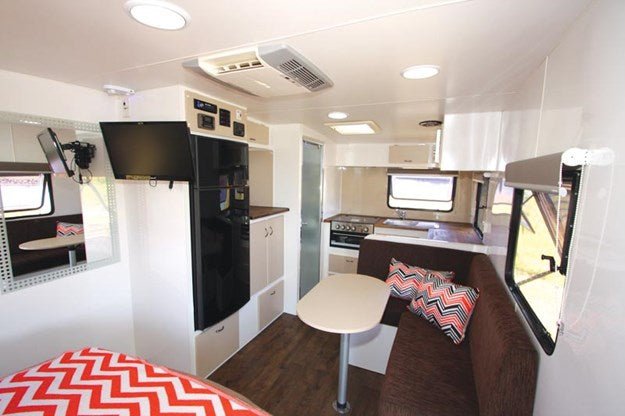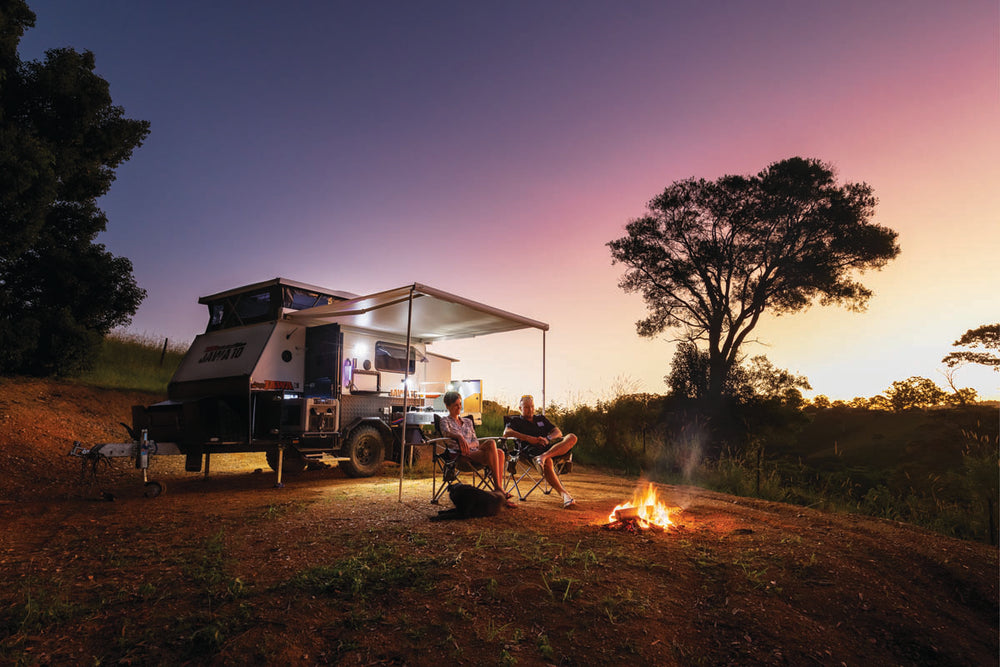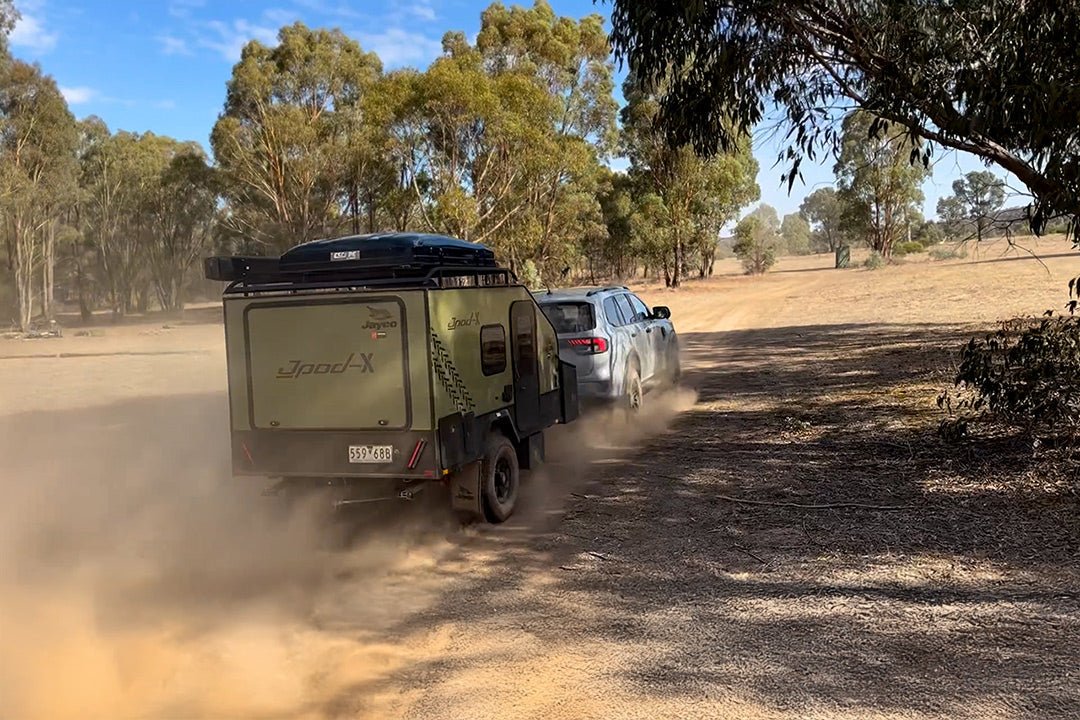Budget Touring: Maintenance

Second-Hand Savers
Many people in our last two generations have had a brilliant ‘anti-waste’ motto drilled into them: Reduce, Reuse, Recycle. According to the National Waste Report, we Australians recycled 60 per cent of our waste in 2014-15. Encouragingly, research conducted by Planet Ark found 85 per cent of Australians agree that recycling at home is the right thing to do — and 78 per cent agree that recycling at home is easy and convenient.
On the home front, we try to put our recycling brain into gear whenever possible. Our local tip shop is our ‘go-to’ destination for all manner of household effects and gardening materials. The great thing about these tip-based commercial outlets is that they can offer an easier option for people to drop off their goods for recycling instead of paying the tip fee associated with dumping. We’re often amazed at the high quality and serviceable gear some people will simply throw away. For example, we’ve paved our bathroom/laundry with brand new tiles still in their box, built a greenhouse from recycled timbers and roofing, and even purchased a couple of really functional roof racks for our tow tug. So, despite the community mantra around reducing and re-using goods, it seems like lots and lots of us are still a pretty wasteful bunch of consumers — more interested in maintaining a steady flow of new goods into our homes than looking for reused options.
But, what’s all this got to do with caravans? Heaps. Trust us.
Next time you’re at the local tip shop, take a good look around. If you do, you may find tools such as axes, rakes and shovels that will work very well around camp. Look out, too, for towing mirrors, plumbing and barbecue supplies. You may even find a few serviceable tyres or rims that have been discarded in their owner’s efforts to free up some storage space in the home garage. Once you start applying this mindset to your quest for auto accessorising, you’ll soon be wondering where else you'll find these treasures.
When this happens, ‘let your fingers do the walking’ and type the words ‘caravan wreckers’ or ‘caravan dismantlers’ into your favourite search engine. You may be very pleasantly surprised at what you’ll find.
Now, it’s true to say that in Australia there are fewer of these places around than was the case 20 years or so ago. Many of our local wrecker yards have closed down. Talking to a few blokes in the business, one main reason is that many vans involved in accidents are simply ‘written off’ and dumped as owners deal with insurance companies. Some wreckers find consumers simply aren’t willing to pay for the labour involved in transporting wrecked vans to the yard, removing parts and storing them. Because a part is secondhand, buyers expect it to be cheap. Otherwise they’ll buy a new part, even if it’s the result of mass production where the intrinsic quality is not as high as the older piece.
But all is not lost. Even if caravan wrecking is on the decline, the business of caravan repair is booming. And many operators keep the old components that they replace ‘off to the side’ for a rainy day. If you’re lucky, they’ll on-sell them to those of us who are keen enough to ask. Do a quick surf on the caravan forums and you’ll find repair workshops all over the place. A place such as Hodgson's Caravans at Redhead, NSW, for example, is renowned online for having secondhand parts upstairs and the new pieces on show downstairs. Now, there’s a place we look forward to looking around next time we’re near Newcastle.
When you consider that parts for discontinued makes and models can be rare as hen’s teeth, and bespoke fixes can be expensive, you have little to lose by checking out what parts are available secondhand in your local area.
MAKING THE MOST OF YOUR FIXER-UPPER
While some of us might be drawn to the opportunities for repairing our existing vans with secondhand parts, others may be in the market to acquire a whole van secondhand.
This can be a great option when you consider how many vans spend the majority of their time stationary in owner’s front yards rather than on the roads. A caravan may have a number of years under its belt, but may have spent very little time out on the roads. Get a good one, and you could save yourself some considerable money on the initial outlay while enjoying some retro-chic. Get it wrong, however, and you may find yourself bleeding money into repairs and be left wondering why you didn’t save yourself the hassle by buying new.
With that in mind, we recently asked a few repairers in our local area for some advice for those of us who may be considering making a secondhand purchase — or adding some creature comforts to the vintage van acquired from a friend or family member. The insights we got were eye opening.
When we asked Andrew from South Coast Caravan Repairs about the most common problems encountered with secondhand vans, it’s clear that water is the nemesis of many owners. Andrew said: “The thing we see the most is water damage — from vintage models to modern caravans that may only be three months outside of warranty.”
In a recent case of water damage, the manufacturer denied responsibility claiming that the problem was due to lack of maintenance despite the fact that the van was virtually new. Andrew told us: “I had to strip the whole front end off the van and rebuild it. Mould had taken over, and, in places it had started to rot. After stripping it back it was clear that the sealant had not been applied well at the point of manufacture. When driven in the rain, water had forced its way through the front panels. After that, the water had nowhere to go.”
As an overarching observation, Andrew advised us about the importance about keeping emotions in check when considering buying a secondhand van.
“Look over it objectively. After all, it’s not yours yet. Look particularly on the inside for water staining near windows and the joints because the sealant can deteriorate over time. Or it may simply have been poorly applied in the first place.”
Justin, the chief caravan repairer at Pharleys Automotive and Caravan Repair, had similar stories about dealing with water damaged vans. He highlighted the risks when owners get too excited about fitting out secondhand vans with all the mod-cons. He told us of the time when a customer came into his workshop with a 1969 Viscount for a rego check. The owner was a carpenter/cabinetmaker who stripped out the original interior and remodelled it with a hand-crafted kitchen. The problem was, the kitchen belonged in a house. It was far too heavy for the van to remain compliant. For registration it was going to need a new axle, electric brakes and associated expenses.
The owner simply hadn’t forecast any of these expenses. So, despite all of the hard work done in renos, the van remains unregistered, to the best of Justin’s knowledge.
While this example may seem a little over the top, whether you’re retro-fitting new appliances like toilets, air-cons or fridges, the risk of overloading is an issue we shouldn’t take lightly.
Justin reminded us that some workshops such as his, can provide pre-purchase check-overs for people considering purchasing a secondhand caravan. Similar to getting a pre-purchase building inspection on a house, or a mechanic’s report before buying a secondhand car, a place like Pharleys can provide this service for caravans. This will include providing quotes to repair any issues identified during inspection. That sounds like a recipe for a good night’s sleep.
NEGOTIATING A DEAL
Looking around the spares in the workshop at South Coast Caravan Repairs, it was pretty easy to get excited about the options, if offered for our own camper project. There was a stack of doors, air-con units, roof vents, water tanks, awning poles, fridges, toilets and washing machines available. The lot — including the kitchen sink. All items had been salvaged in working order from various makes and models of van. Why? Generally, because the previous owner either hadn’t wanted it or had upgraded to a smaller one — or a bigger one — or a shinier one.
The stand-out item was the almost-new caravan washing machine that the owner had ditched because the lid hinge had snapped. The manufacturer preferred to simply replace the whole unit under warranty rather than provide a new lid. A bit of ingenuity, and that little washer would be fixed in a heartbeat.
Offcuts of checkerplate were exactly what we needed for some panel protection. Far better than buying a 2.4x1.2m sheet for around $160. And what about the discarded stoneguards from a couple of vans? The dents at one end of the sheet wouldn’t stop us making good use of the remainder.
With a few choice pieces chosen, some friendly negotiation, and a hand-shake, we were on our way.







